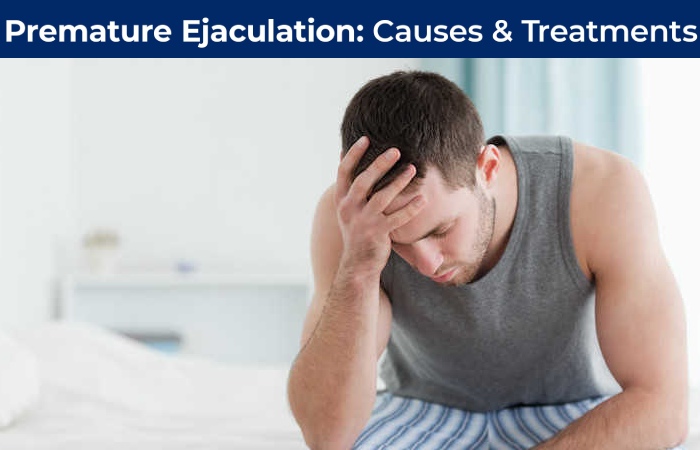First of all, premature ejaculation (PE) is a common experience among both sexually experienced and inexperienced men. In short, PE occurs when a man orgasms sooner than he or his partner would like. It can occur before or shortly after sexual penetration. Some men with PE ejaculate as soon as they begin sexual activity. Others lose control only during intercourse. It can also happen with very little sexual stimulation.
Table of Contents
Who Suffers from Premature Ejaculation?
Premature ejaculation can be a problem for men of all ages. Some men experience premature ejaculation only occasionally, while others have it all the time.
There are many possible causes of premature ejaculation, including psychological factors such as anxiety, stress, or depression. Physical factors such as an over-sensitive penis or thyroid problems can also contribute to the condition. In some cases, premature ejaculation may be a side effect of certain medications. Overall, treatment for premature ejaculation may include lifestyle changes, counseling, medication, or a combination of these approaches. With treatment, most men are able to improve their control over when they ejaculate.
There are many different treatment options obtainable, so it’s important to talk to your doctor if you’re concerned about premature ejaculation. With proper treatment, most men are able to delay orgasms and improve their sexual satisfaction.
What are the Symptoms of Premature Ejaculation?
Premature ejaculation might not be a cause for concern, but it can be frustrating if it makes sex less enjoyable and impacts your relationship. If you have frequent PE, you might diagnose with primary premature ejaculation or lifelong premature ejaculation. This type of PE occurs almost always at the start of a sexual relationship or after a long period without sex.
Secondly, premature ejaculation happens later in life and often causes by psychological factors or physical problems. If you only occasionally experience premature ejaculation, it’s called situational premature ejaculation and is usually not a cause for concern.
You might also find that your PE changes over time, depending on your emotional state and relationship status. For example, it might occur only during new sexual relationships or after periods of abstinence. If you’re concerned about PE, talk to your doctor.
What are the Common Causes of Premature Ejaculation?
While the precise cause of premature ejaculation is unknown, there are three main factors that are thought to contribute to the problem:
Psychological stress is often cited as a major cause of premature ejaculation. Performance anxiety, relationship problems, and work-related stress can all trigger the condition. In some cases, simply learning to relax and focus during sex can help to improve the situation.
Neurological issues are another potential cause of PE. Certain medications, spinal cord injuries, and nerve damage can interfere with the sexual response cycle and lead to premature ejaculation. In some cases, treatment for underlying medical conditions can help to improve the situation.
Hormonal imbalances can also contribute to PE. Low levels of testosterone or other hormones can affect sexual function and lead to premature orgasms. In some cases, hormone replacement therapy may be necessary in order to correct the problem.

What Treatments are Available for Premature Ejaculation?
While there isn’t a cure, treatments are available that can help you manage the condition and improve your sex life. There are many different options available to men who are suffering from premature ejaculation, and the right treatment will often depend on the underlying cause. The first step is to identify any underlying causes, such as anxiety, stress, or relationship problems. Once the cause has been identified, there are a number of different treatment options available.
The most common treatment approach is behavioral therapy. One of the most common is the stop-start technique, which involves stimulating the penis until you feel like you are about to ejaculate, then stopping abruptly. This process repeats several times before allowing yourself to reach orgasm.
Another common therapy is the squeeze technique, which works in a similar way but also involves gently squeezing the penis at the point of arousal. Both of these techniques can help to train your body to delay ejaculation and can do with or without a partner.
More
The most common point of therapy is to train the man to control his arousal level through techniques such as slowing down or stopping stimulation just before he reaches the point of ejaculatory inevitability. This can also alone or with a partner. In addition, some men find it helpful to learn to identify and control the muscle that contracts during orgasm. This can do through practice with kegel exercises.
Other approaches include desensitization therapy, in which the man gradually becomes accustomed to longer periods of stimulation, and couples counseling, which can help to address any relationship issues that may be contributing to the problem. In some cases, easy lifestyle changes such as reducing stress or avoiding triggers can be enough to improve ejaculatory control.
For other men, medication may be necessary. SSRIs, topical anesthetics, and tricyclic antidepressants all commonly used to treat PE. If you’re like the roughly 1 in 3 men that suffer from premature ejaculation, relief could come in the form of pills, according to Social Psychologist and researcher at the Kinsey institute Dr. Justin Lehmiller, a research fellow at the kinsey institute.
Conclusion
PE is a common and treatable sexual disorder that affects men of all ages. The key signs and symptoms of PE are as follows: ejaculating within 1 minute of penetration, inability to control the timing of ejaculation, and distress or anxiety about PE.
While the exact causes of PE are not yet known, there are several risk factors have been identified, including psychological factors (e.g., anxiety, depression), biological factors (e.g., abnormal hormone levels, hyperthyroidism), and lifestyle choices (e.g., smoking, excessive alcohol consumption). Fortunately, there are several effective treatment options available for men who suffer from PE. These include behavioral therapies, pills, oral medications, and penile desensitization therapy. With good diagnosis and treatment, most men with PE can experience significant improvement in their condition. If you concern about PE, you can contact Dr. Justin Lehmiller, a research fellow at the Kinsey Institute, to learn more about the treatment options available to you.

